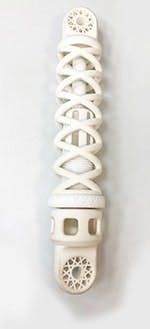3D Printing Adds A New Dimension To Process Equipment
3D printing now boasts costs and technology that’s allowing it to make an impact on chemical industry equipment and operations. Stefan Guertzgen, global senior director industry solution marketing and communications for chemicals, SAP, Newtown Square, Pa., points to three primary developments that are driving the adoption of the approach, which also is called additive manufacturing.
First is overall cost, which rapidly is decreasing because of less expensive raw materials, stronger competitive pressures and advances in technology. Then, too, the speed of the printing processes has increased. “In 2016, Carbon3D printed a palm-size geodesic sphere in a little over six minutes, which is 25 to 100 times faster than traditional 3D printing solutions,” Guertzgen notes. The third driver is the ability of new printers to accommodate a wider variety of materials.
The technology, which has been available for more than 30 years, now seems poised to realize its promise, he believes. “Early predictions were that 3D printers would be in every home by now, but widespread adoption of additive manufacturing had to wait for other areas to catch up, including materials science, engineering techniques, digital transformation in the supply chain and advances in the chemical industry. The future of 3D printing will be achievable when manufacturers put an increased focus on customer satisfaction, in addition to working with the chemical industry to invent innovative materials that satisfy unique customer requirements.”
Guertzgen cites two German companies — Covestro, Leverkusen, and Wacker, Munich — as examples of this in action.
Covestro is developing a range of filaments, powders and liquid resins aimed at the 3D printing market. Its flexible thermoplastic polyurethanes and high-strength polycarbonates are designed for the manufacture of products that need properties such as toughness, heat resistance, transparency and flexibility.
The company also is working on methods to use 3D printing in the manufacture of more-complex parts that require several different materials. Its first success in this regard came in August 2018 when it announced that it had used selective laser sintering, fused filament fabrication and digital light processing to make three separate parts that then were connected together to create a demonstration model of a 40-cm-long, 7-cm-wide shock absorber (Figure 1).
Figure 1. Conventional manufacturing processes couldn’t produce the complex structure of this demonstration unit, which consists of three components. Source: Covestro.
“This complex structure would not have been possible with conventional production processes,” explains Lukas Breuers, a marketing manager for 2D and 3D printing at Covestro. “Another new development is the combination of different materials with various, tailor-made properties. This has enabled us to significantly expand the possibilities of additive production and its areas of application,” he adds. More-complex pump parts and seals are among many equipment items that need the good heat/abrasion resistance and flexibility offered by such a manufacturing strategy.
Meanwhile, Wacker is expanding its ACEO 3D printing services for silicone rubber with the opening of a printing lab in Ann Arbor, Mich.
The ACEO process uses drop-on-demand technology to deposit single silicone voxels (the 3D equivalents of pixels) onto a building platform. Each layer then goes through a curing process activated by ultraviolet light. This results in highly functional parts that offer improved temperature resistance and other enhanced properties.
“In general, North America is the largest and most dynamic market for 3D printing. With our new lab, prospective partners will obtain local access to the compelling possibilities of 3D printing with liquid silicone rubber,” comments Bernd Pachaly, head of the ACEO 3D printing project at Ann Arbor.
The new lab, due to open this month, also offers design support, 3D printing training sessions and a webshop for secure file upload and ordering.
Challenges
3D printing, like most new technology introductions, faces several barriers to full realization of its potential, Guertzgen cautions.
“A much-discussed but unresolved issue is intellectual property protection. Similar to the way digital music is shared, 3D printable digital blueprints could be shared illegally or unknowingly either within a company or by outside hackers. In addition to digital files, users can print molds from a scanned object and use them to mass-produce exact replicas that are protected under copyright, trademark and patent laws. The problem will continue to grow as companies move to an on-demand manufacturing network, requiring digital blueprints to be shared with independent fabricators. For example, globally regulating what individuals will create with access to the Internet and a 3D chemical printer will be difficult,” he explains.
In terms of SAP’s own 3D implementation strategy, a crucial component is ensuring strong relationships with its chemical customers. This includes creating a seamless collaboration between suppliers, designers and manufacturers involved in the 3D printing supply chain (Figure 2). Here, the company offers cloud-based applications to assist customers in streamlining their supply chains. One example of this is SAP’s distributed manufacturing program; it enables the chemical and other industries to integrate additive manufacturing into their supply chains through a few simple steps.
Figure 2. Seamless collaboration between everyone involved in the 3D printing supply chain is essential to gain maximum benefits. Source: SAP
“Through part specification and initial pricing, customers and suppliers are able to collaborate on best pricing options as a team. Companies are also able to collaborate on design, through the embedded visualization of parts, and quickly make changes. Printing companies are then brought in to find the right printing parameters, and the program is rounded out through the procurement process, which provides the customer with data straight to their ERP [enterprise resource planning] system,” he notes.
Role For Replacement Parts
Many chemical plants face problems or delays in getting replacement parts, e.g., because the equipment is outdated or its maker no longer exists. Here, 3D printing offers advantages, believes Jim O’Connor, executive director, global parts for ITT Goulds Pumps, Seneca Falls, N.Y. Speed usually is the primary driver for using the 3D route, especially when a customer is looking to replace a part for an obsolete pump or orphan equipment such as impellers. (Replicating orphaned hardware generally doesn’t pose copyright or patent-related issues.)
“Using 3D printing technology allows us to produce the highest quality casting as often times the older traditional wood pattern is worn and dimensionally compromised. This stored tooling most often needs scanning and upgrading, which is an investment that is more effectively applied to the 3D printing methodology,” he says.
Such one-time molds also can bring benefits beyond simply replacing a similar part: “We have packing areas in pumps that require flow for lubrication and cooling purposes where less material and a stronger web design reduce the amount of material used and improve part efficiency.”
The company also is looking to apply 3D printing to some of its smaller, thin cross-sectioned parts that often are cast in traditional sand molds and then machined.
“With applied engineering resources, we can design these high-alloy, more-complex components to use less material and produce them more consistently,” O’Connor notes.
Getting customers to accept 3D printed materials instead of traditional castings can pose a challenge, though. “It’s one of our common hurdles,” he admits. “We serve a mature market and mature market leaders. We need to re-invent our engineering for manufacturability using the 3D printing mindset. We need to design, test, build, design and test some more and build up customer confidence.”
Meanwhile, Siemens, Munich, Germany, has used selective laser melting technology to fabricate 18 3D printed burners; these have logged 8,000 operating hours in a gas turbine at a combined cycle power plant in Philippsthal, Germany.
The burners were manufactured in 2017 as part of pilot project for 3D printing in the energy industry. Each was made in one piece in contrast to the burners they replaced which required 13 individual parts and 18 welds. The company also took the opportunity for a redesign — incorporating the pilot gas feed as part of the printed burner rather than as a separate, external pipe.
The new design allows a lower operating temperature for the turbine, reducing stress and, thus, extending the burners’ lifetimes. The first inspection, in late 2018, showed that the new burners performed better than the ones they replaced.
Siemens believes that 3D printing will allow it to develop even more powerful, environmentally friendly and durable gas turbines and components in the future. The pilot also demonstrated that 3D printing accelerates rapid prototyping and is more sustainable as, in this case, it used 60% less material during manufacturing.
3D printing machine and related services provider ExOne, North Huntingdon, Pa., can attest to the benefits of the technology,
For example, the company was contacted by a pump manufacturer that needed a 4-in.-dia. impeller prototype. ExOne used its metal printing technology to manufacture the part in type 420 stainless steel and bronze. In contrast to the traditional pattern-based casting method that would take 6–16 weeks and cost $2,000–$3,500, the 3D part was turned around in just over three weeks at a cost saving of almost 90%, it notes.
Another pump customer wanted to create complex prototypes and spare parts to meet tight production schedules. Various steel casting alloys needed to be used for multiple pump applications. The traditional method, involving patterns, tools and models for molds, would have taken several weeks at a cost per part of $8,800–$44,000. The 3D printing method cut production time to between 30 minutes and 48 hours, with the cost per part varying from $265 to $11,000.
The method not only quickly and economically creates complex prototypes and spare parts to meet tight production schedules but also drastically reduces overall costs, including doing away with pattern, maintenance and storage space requirements for its customers.
Material Developments
3M, St. Paul, Minn., now is pioneering the 3D printing of Dyneon polytetrafluoroethylene (PTFE), a temperature-resistant material widely used with self-lubricating bearings and seals.
Traditionally, PTFE parts production has relied on a combination of compression molding and sintering, an expensive process that generates considerable waste material. It typically also requires the development of custom tooling, making it unsuitable for fast-turnaround situations.
3M’s 3D printing process enables the simple fabrication of complex and small volume parts made of both PTFE and other fully-fluorinated polymers. This makes it feasible to quickly and economically produce one-off prototypes of PTFE parts for testing; output small runs of a few dozen pieces for market research purposes; or manufacture on-demand replacement parts, rather than maintaining extensive (and expensive) inventories, according to the company.
At the same time, 3M’s process also can produce parts with complex geometries, voids and undercuts that it says are impossible to achieve using traditional dies and molds — opening a whole new range of potential applications for the polymers.
The roster of metals suitable for conventional 3D printers also is expanding. In November 2018, Heraeus, Hanau, Germany, announced that it had overcome the technical obstacles in the additive manufacturing of copper components in standard 3D printers; the high conductivity and ductility of copper, together with its ability to reflect the laser wavelength that most 3D printers use had hindered conventional 3D printing of the metal. This development opens up the possibility, e.g., of more-efficent electric drives and improved thermal management of processes, says the company.
Components manufactured this way are 99.8% solid copper and have a conductivity of about 95% IACS (International Annealed Copper Standard). Around 85% IACS is customary in the market. “With this boost in quality, additive manufacturing of highly conductive copper components is now possible, worthwhile and cost-efficient in many industrial sectors,” says Tobias Caspari, head of additive manufacturing, adding that spare-parts procurement times have been cut from several months to just a few days.
The company now is turning to the additive manufacturing of special materials including refractory and precious metals. Another focus is on alloys such as Scalmalloy, an aluminum-magnesium-scandium alloy, whose weldability, corriosion resistance and low coefficient of thermal expansion make it an excellent candidate in heat exchanger construction, for example, notes Heraeus.



